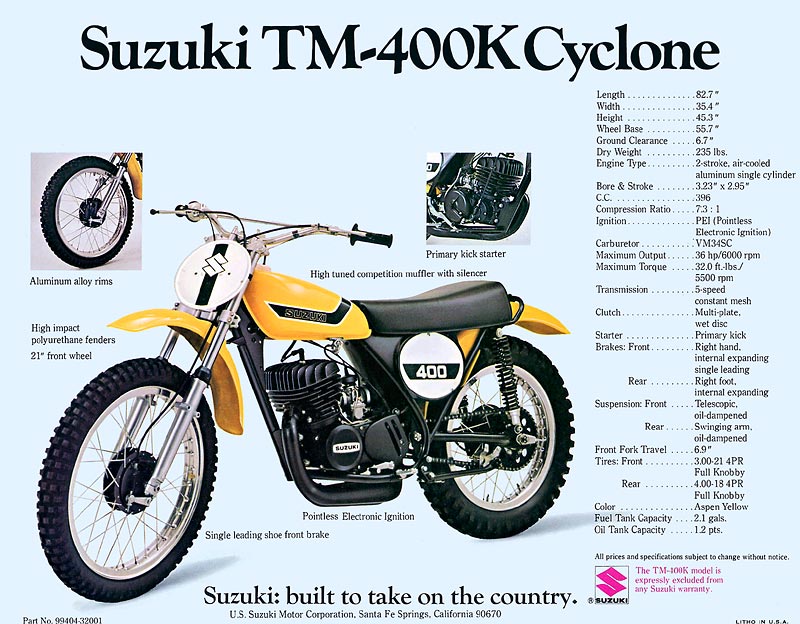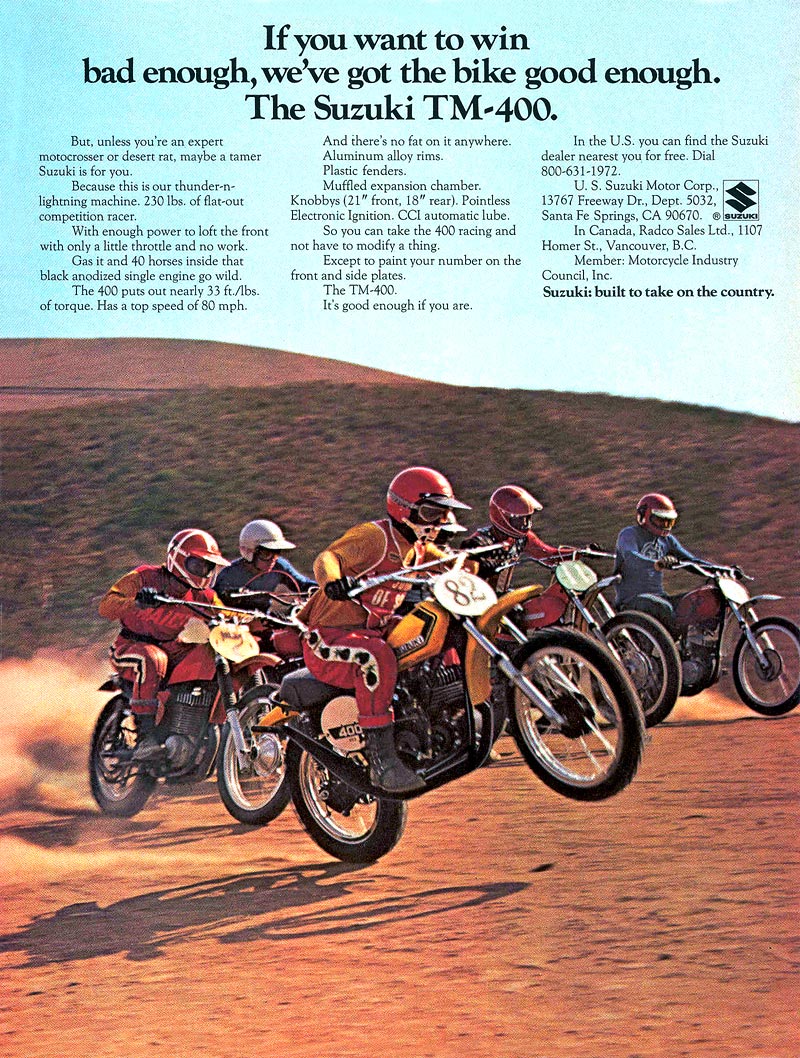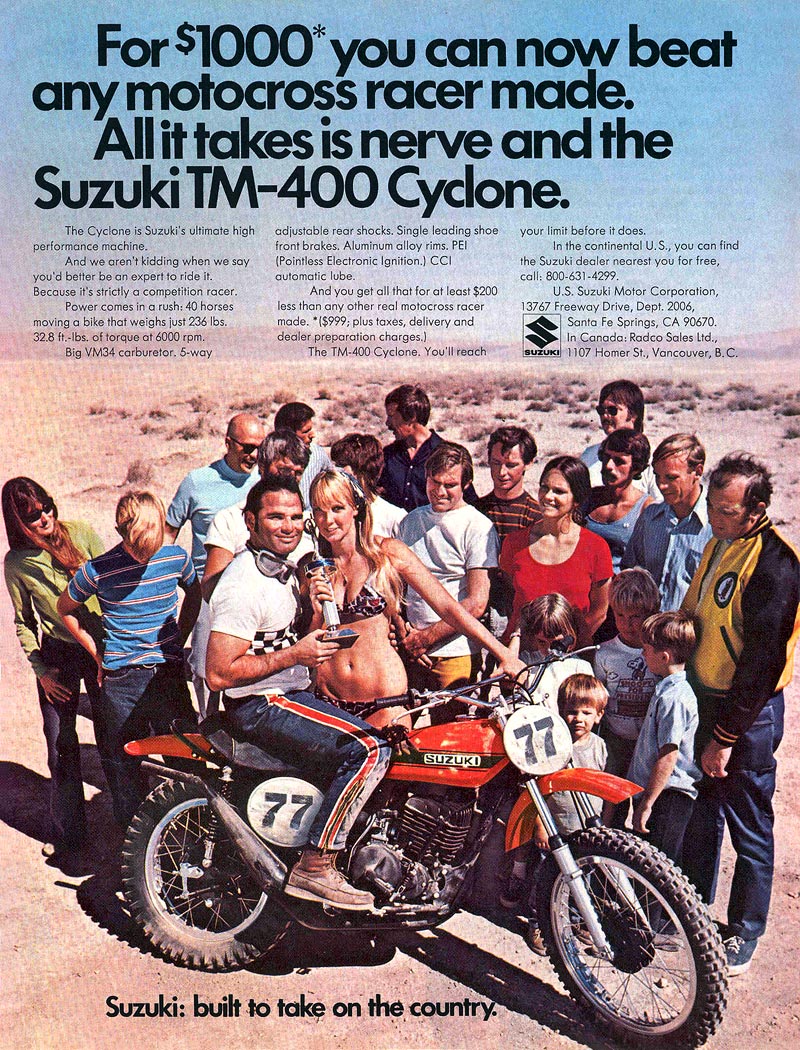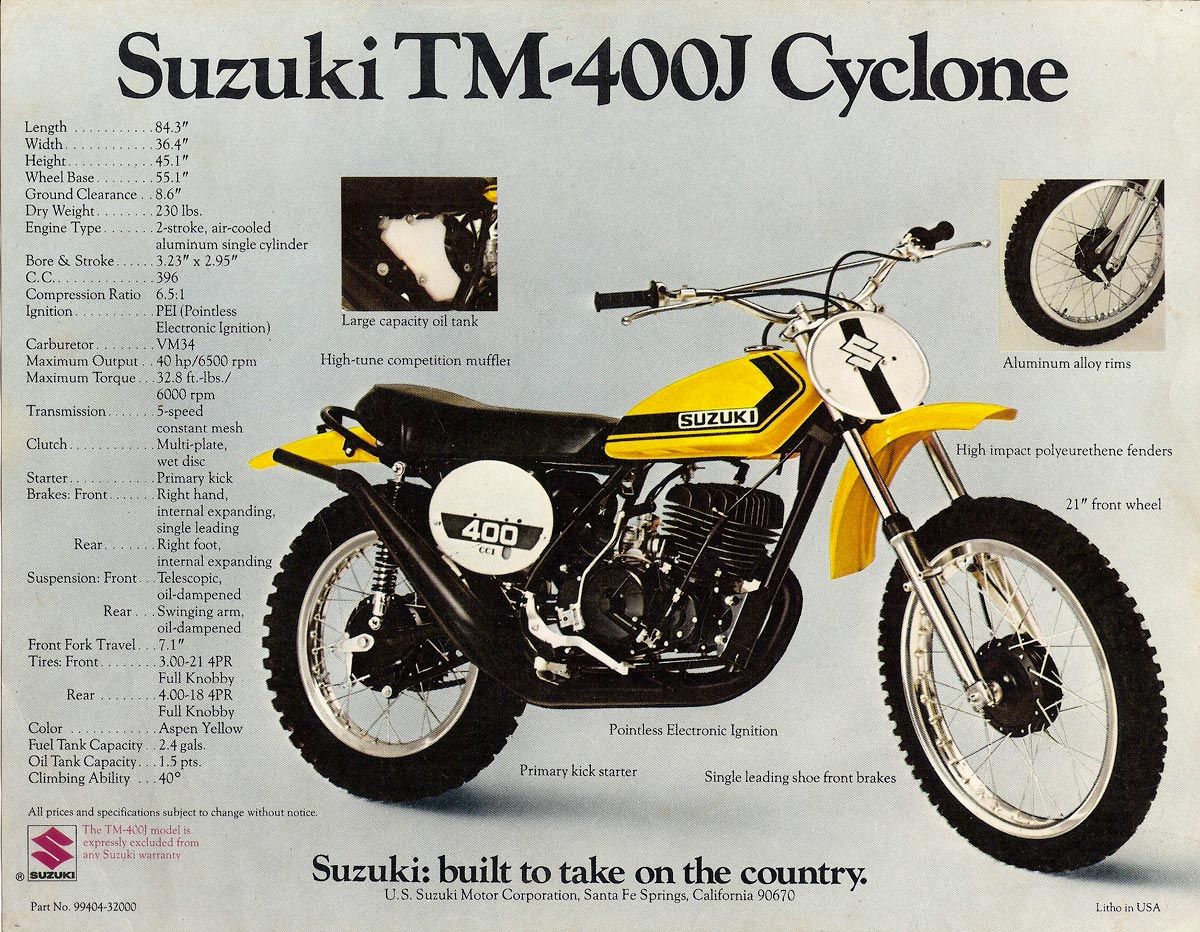Vintage_Mania
Bachelor Dog

Ever since that first orange tanker hit the tracks in 1971, people have been buying, racing and falling off 400s in mass‑ production numbers. They bought ‘em ’cause they were far and away the cheapest way to go big-bore racing; they raced ‘em ’cause, “Lookit what that Belgian dude does on one;” and they fell off because the Cyclone had to be the most evil package of raw power and horrible handling ever produced. So the bike became a legend in its own time, and the legend was a horror story. Rosy-cheeked farm boys could always be counted on to enter the Transylvania Grand Prix on Cyclones, with the Marquis de Sade as their sponsor. Blood City was the result, and Billy Dracula cleaned off the course.
Why so? Is the legend of the TM400 for real? And, if so, is it still valid in 1974?
Sidle up to a Cyclone and give it the once-over. Hmmmmmm, pretty bike. Lots of bright racing yellow, flat black and a tank striped with what they used to call British Racing Green. Tank has a nice shape to it too, even if it is steel, and the accessory-type items look pretty neat. Good levers, unbreakable fenders, imitation DID rims, decent grips and bars and a narrow seat that’s just the least bit underpadded. OK, swing a leg over and get the feel. Good seating position, long as you’re at least 5’8″, and everything seems to be in the right places. Feels good. Touchy, touch; feely, feel; brake in and shift up. Ah yes, it’s all there, right where it should be. Is this really a TM400? Best to strip off a layer and look a little closer. Well designed still air box. Ours came with a paper filter inside, but the American models are supposed to have foam. If yours doesn’t, throw the paper away and get something decent like a Twin Air. External silencer does a pretty good job of quieting the savage beast. Oops, oil injection. B00000. Ah, trimmed down front forks with no fender lugs. Yeaaaaa. Damn, they trashed those good pegs and put on neatsy looking alloy numbers that won’t drain. Well, guess we can’t avoid it any longer, gotta take her out to the track and find out what it’s really all about. Stand back, world, the Cyclone’s on its way.

Loading the 400 is where the bad vibes begin. This motorcycle is TOO HEAVY, like 247 pounds wet. The way we see it, 230 would be in the ballpark for an Open machine, 220 if you wanna be really competitive. But 247 is awful. All that weight tires the rider out, makes overriding the bike’s myriad errors difficult to impossible, and just plumb does in the basically decent suspension components the 400 is fitted with—decent, that is, on a bike substantially lighter than this one. Of course, you can always lighten the Cyclone by trashing the oil injection (do it regardless) and indulging in the normal type of Motocross Weight Reduction Techniques, but the heart of the weight problem lies in an area where it’s just about impossible to correct—the frame. The TM400 has got to have a lighter frame. Unfortunately, “lighter” usually means “weaker,” and the 400’s frame is already so weak it flexes. An overweight frame that flexes has got to be the worst of two worlds.
And flex it does—and, since what flexes has to reflex, TM400 owners are constantly finding themselves in a world of hurt, not to say pain. To truly understand what happens when you twist the Cyclone’s throttle and find yourself body surfing a nearby berm, take a look at the bike’s power characteristics. That, in turn, will lead you back to the flexing frame, since in truth there’s no way to avoid it.
The TM400 is basically a soundly designed motorcycle, with fairly good weight distribution, engine placement and frame geometry. Its problems lie in, a) the power characteristics, b) the lard and c) the flexiframe. Hand in hand, these work to make the Cyclone a sobering experience to ride.

Twist the throttle and the power comes on like an exploding cigar. That’s OK for some people, but it only works well on lightweight bikes. On a bike which weighs 247 out of the gate, that kind of instant, all or-nothing blast is semi-useless and totally dangerous. Blame the way the power comes on on the light crank and the CDI ignition (or, as Suzuki would have it, the PEI ignition). CDI-type ignitions are neat in that they don’t easily go out of time and will throw a spark under six feet of water, but they tend to adversely affect an engine’s power characteristics. On the TM400, this tendency manifests itself in a power rush which is not only violent, but unpredictable. It’s bad enough to know you’re going to get hit in the tail with the proverbial Mack truck, but it’s worse when you don’t even know exactly when.
The Cyclone needs a heavier crank and a magneto. The works 370s (those being what Roger and the boys really ride) have magnetos. True, a magneto is more of a hassle to maintain, but it also costs less and puts out smoother power. And it’s a great help to your progress around a motocross track to know what you’re going to get and where when you hit the “go” button.

The fun stuff works like this: When you goose the power the motor instantly generates a whole big bag of horsies (no one has ever accused the 400 of being down on power). But because the bike weighs so much, all that power which is being transmitted to the rear wheel doesn’t do the job right away. Like just for an instant. So the wheel stays put (just for that instant), and the power (which has gotta do somethin’, right?) pulse gets transferred back through the wheel and into the frame. The frame at this point is the swingarm, and the swing-arm (bless it) flexes. Just for that instant. Then the rear wheel gives up trying to move the bike and breaks loose (wheelspin). The power that flexed the swingarm is now released to the spinning wheel, and the swingarm snaps back (reflex, remember?). Now, that flexing frame carries with it another type of energy in the form of 247 pounds of moving (reflexing) mass, so when the reflex action starts, it just keeps moving. That’s known affectionately as “side hop.” At this point, if there’s no traction to be had the rear just continues sideways. If there is traction, however, more energy gets transferred to the frame and the process is repeated the other way, then back, then forth, then back, then forth, ad insanitum. When this starts happening while you’re tapped in fourth on a bumpy section, you’d best hope that your hospitalization is paid up. Because this hippity-hop action is the direct result of the power/frame combination, the only way to get the TM400 back under control when all this happens is to shut everything down and hold on hard—instead of just screwing on more throttle like you’d do on any other bike.. If you don’t, you’re likely to be placing one of those ads you see all the time in the weekly papers that go, “For Sale TM400 Cyclone, raced once. Injury forces sale.”
The remedy for the Cyclone’s problem (besides using a magneto ignition) is to 1) alter the trail up front to help the beast steer better in the turns (where it traditionally likes to highside a lot), and 2) make the frame stronger. Since the frame is already too heavy, this means a chrome moly frame. Bucks, big bucks.
The 400 is geared a little high for real in-and-out motocross, but a larger rear spocket will help out there. The gearbox itself is as smooth as a trophy girl’s kiss and a lot more reliable. The very malleable shift lever bends easily, but it also bends back easily, so…
As units, the wheels are damn nice. Good brakes, some of the best in the industry, reasonably light-weight hubs, good rims, rimlocks, etc. The tires suck, thus accentuating the Cyclone’s skittery manners, but you’ll soon spin the knobs off them anyway. Get something soft that clings, ’cause if you do go racing on a TM400 you’re going to need all the help you can get.

With the proper amount of rider care and machine preparation, the Cyclone can be an OK playbike, even an econo-crosser, but the racer with any smarts who finds himself sitting one is going to constantly feel as though he’s teetering on the thin edge of destruction. The bike works best on tracks with LOTS of traction to give that power something to knuckle into, and when riding it, the wise rider will pick the lines that afford the best traction—not just to go faster, but to stay in one piece. Still, if you’re down bucks and wanna go fast, it is one way to go racing. Sort of.
One of our staff likes to recall those days of yesteryear when he was sponsored on a stocker and won a lot of races—except when it rains. When the water comes down, the aches set in, and our boy just curls up like a pretzel and groans. He raced on a ’71 orange tanker, but nothin’s really changed





